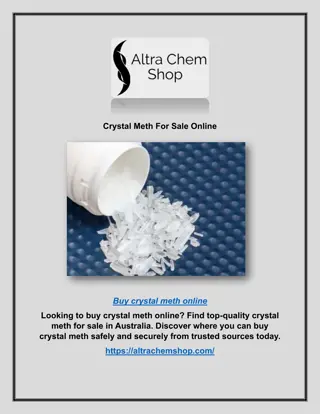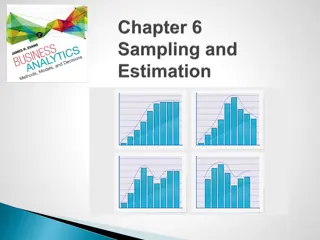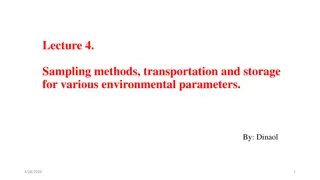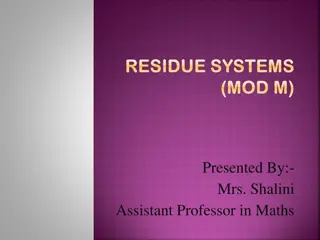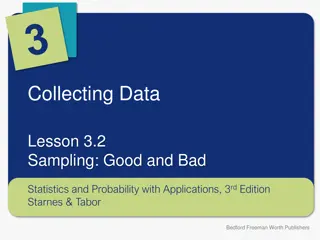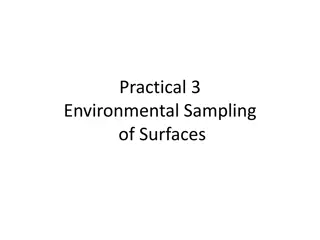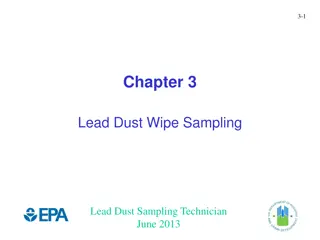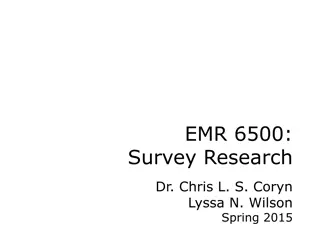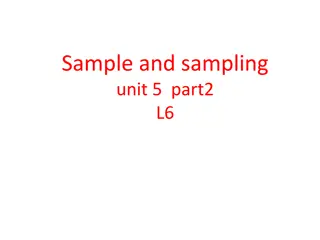Comprehensive Guidelines for Meth Residue Sampling by Local Health Departments
This detailed guide outlines the procedures and protocols for meth residue sampling conducted by local health departments. It covers the reasons for sampling, the importance of qualified inspectors, testing methodologies, sampling kits assembly, and more. Key points include when and why sampling is necessary, the role of health officials, testing requirements, and recommended sampling techniques. Ensuring thorough and accurate sampling is crucial in identifying and addressing potential methamphetamine contamination in residential properties.
Download Presentation

Please find below an Image/Link to download the presentation.
The content on the website is provided AS IS for your information and personal use only. It may not be sold, licensed, or shared on other websites without obtaining consent from the author. Download presentation by click this link. If you encounter any issues during the download, it is possible that the publisher has removed the file from their server.
E N D
Presentation Transcript
Meth Residue Sampling by Local Meth Residue Sampling by Local Health Departments Health Departments Steve Yeary, REHS Environmental Public Health Division Indiana State Department of Health 9/26/2017
Why would a LHD sample? NEVER when there s a clear OR of drug manufacture in a residence 1. When there is strong suspicion that manufacture occurred in a residence, but there is not an OR to clearly show this -or- 2. To check up on a QI s cleanup
LHD Sampling2 318 IAC 1 requires Qualified Inspectorsfor certifying sites as clean and issuing the Certificates of Decontamination So, NEVER sample to clear any property that has an OR indicating drug manufacture occurred within a residence
LHD Sampling3 Health officials enter and inspect private property for the possible presence, source, and cause of disease under the authority in IC 16-20-1-23 The ISDH lab can test meth residue samples FREE for county health departments, as long as the LHD is not attempting to clear a home, or fill the role of the QI
LHD Sampling4 LHDs only need to show that some portion of a property is contaminated and then require further assessment by a Qualified Inspector Focus sampling on the areas suspected of having the worst contamination Take a small number of individual samples (batches of 6, including any blanks) Always test the HVAC system
LHD Sampling5 Field kits/indicators NOT recommended Samples must be analyzed using EPA 8270C or equivalent (a lab) Collect wipe samples using ASTM D 6661-01 (follow ISDH lab protocol)
Assemble a Sampling Kit1 1. Contact Mark Starzynski @ ISDH labs (317) 921-5580 to get sample VOC vials, 3x3 sampling gauze, forms, and the sampling protocol.
Assemble a Sampling Kit2 2. Obtain lab-grade methanol as the wipe solvent. ISDH cannot ship HAZMAT. ISDH can provide in person VWR International is a supplier 1 (800) 932-5000.
Assemble a Sampling Kit3 3. Make or obtain 10cm x 10cm templates. Environmental Express is one option; 843-881-6560.
Assemble a Sampling Kit4 4. Use a fresh set of nitrile gloves for each sample to prevent cross-contamination 5. Use a syringe or dropper to wet the 3x3 cotton sampling gauze with methanol (3-5 ml) 6. Zip lock bags, marker, and tape 7. A protective storage container is recommended
Wipe Sampling1 1. Pick sample locations and label vials/forms appropriately 2. Plan for at least one blank (1:10 ratio) 3. Tape the 10 cm by 10 cm templates at the selected locations 4. Make a sketch and/or take photos
Wipe Sampling2 5. Wear new gloves for each sample 6. Wet a piece of cotton sampling gauze with methanol, using a clean syringe or dropper (same syringe or dropper throughout site) 7. Squeeze out excess methanol
Wipe Sampling3 8. Fold the gauze once, wipe back and forth. Cover all the area inside the template
Wipe Sampling4 9. Fold the gauze again, wipe up and down. Cover all the area inside the template
Wipe Sampling5 10.Put each wipe in its own pre-labeled VOC Vial for the ISDH lab 11.When finished, create one field blank by wetting a clean piece of gauze with the same methanol and syringe/dropper 12.Ship/deliver to ISDH lab
Interpreting Sample Results Indiana s standard in 318 IAC 1 is 0.5ug/100cm2 A health official should use IC 16-41-20 to order a contaminated home vacated until remediated per 318 IAC 1 whenever samples exceed the standard.
Your Safety IF you enter: 1. Criminal Element 2. Immediate chemical threats; explosions, fires, burns to eyes/skin 3. Chemical vapors/particulates associated with an active cook 4. Residual contamination; skin absorption 5. Sharps & biohazards
My contact info: Steve Yeary, REHS Environmental Public Health Division Indiana State Department of Health 317-964-1442 styeary@isdh.in.gov







